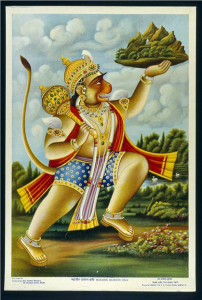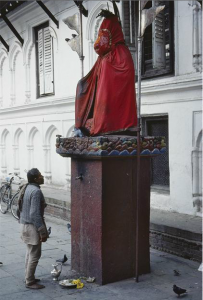In recent decades there has been a widespread proliferation of Hanuman— the monkey deity— worship and iconography throughout India. While he is perhaps most famous for his role as a loyal Rama-devotee in the epic Ramayana, Hanuman is also the subject of numerous Bhojpuri folktales, songs, and poems, and has thus evolved to embody the ideals of the elite and the folk, the traditional and the contemporary, the hero and the sidekick. It is in this way that Hanuman has successfully become the symbol of two fundamental, and arguably conflicting, concepts— bhakti (devotion) and shakti (power) —that are central to the teachings of Hinduism. A multitude of stimulating arguments have been made attributing Hanuman’s growing popularity to one of a number of different factors (politics, socioeconomics, gender, etc.) However, it is important to recognize that it is precisely this variation in factors that may itself explain why Hanuman is so widely celebrated in contemporary Hinduism.
In the context of the Ramayana, we see Hanuman—also commonly referred to as Son of the Wind— as defined by his intense and undying devotion to Rama, the protagonist of the epic. As leader of the monkey army, Hanuman plays a crucial role in the battle against Ravana, the demon king who kidnaps Rama’s beautiful wife, Sita. Hanuman leaps one hundred leagues across the ocean, burns down the city of Lanka, saves Sita, and even moves mountains with his bare hands. Still, despite possessing many praise-worthy attributes, Hanuman is first-and-foremost depicted in the Ramayana as “a devoted servant of Rama, motivated and empowered by the fixity of his love” (Wolcott, 654). In the final chapter of the Ramayana, Rama thanks Hanuman for his service and rewards him with a priceless gem bracelet, to which Hanuman replies: “Lord, though this bracelet looked expensive it was really worthless, for nowhere on it did it bear your name” (Buck, 426). Then, in an act of unconditional devotion, Hanuman rips open the flesh of his chest to reveal that, “written again and again on every bone, in fine little letters [was] Rama Rama Rama Rama Rama” (Buck, 426). It is in this way—through spectacularly selfless acts of passionate servitude— that Hanuman takes on the role of the “perfect Rama-bhakti” and becomes a symbol of devotion in popular Hinduism (Wolcott, 655).
In contrast to his character in the Ramayana, the Hanuman of Bhojpuri folklore tends to be a central protagonist, often characterized by his superhuman strength, rather than by his servitude. This view of Hanuman as a strong heroic figure, separate from Rama, works to inform the emergence of Hanuman as a symbol for shakti, which is extremely important to the lives of Bhojpuri men— everything from “the growth of grain in the fields [and] the produce of cattle, [to] the strength of oxen are all dependent on this energy” (Wolcott, 658). Thus, through Bhojpuri folklore, Hanuman evolves into a symbol of attainable strength in everyday life— in contrast with the seemingly unattainable concept of brahman that governs the broader teachings of Hinduism (Wolcott, 658). Another characterization of Hanuman as a symbol of shakti can be found in the veneration of Hanuman among Shiva ascetics. In the folktales of this tradition, “Hanuman receives shakti from Shiva and Parvati, and thereby becomes an incarnation thereof, giving it identifiable form and personality” (Ludvik, 11).
In the past few decades, many researchers have speculated about the reasons for Hanuman’s growing popularity. In Philip Lutgendorf’s book (Hanuman’s Tale: The Messages of a Divine Monkey), he posits that there exists a correlation between growing Hanuman worship and the growing middle class — a group that is “in-between and notoriously hard to define”— in India (Lutgendorf, 371). Lutgendorf argues that through his role as “a liminal immortal who delivers both the gods and the goods, Hanuman embodies the moxie and resourcefulness required to get ahead, paradoxically coupled with the reverence for order and hierarchy that often signifies having arrived” (Lutgendorf, 375). This plasticity in Hanuman’s character seems to mirror the heterogeneity of the Indian middle-class and thus, allows him to appeal to such a diverse population.
Alternatively, in his article “My Hanuman Is Bigger Than Yours”, Lutgendorf posits that the phenomenon of Hanuman worship can be attributed to the growing influence of Hindu militants—whose “rhetoric glorifies assertiveness, aggressive masculinity” and physical brawn (Lutgendorf, 243). The iconography of Hindu militants portrays Hanuman as extremely muscular and hyper-masculine, suggesting that his popularity may be attributed to the increasing emphasis on masculinity and strength within the sociopolitical environment of India.
A third explanation—and perhaps the most compelling— explains Hanuman’s growing popularity in terms of the simplicity of Hanuman worship. “Modern devotees praise [Hanuman] as an easily propitiated god, who is satisfied with a hurried Calisa recitation or a few rounds of Ram-nam” (Lutgendorf, 243). This is important because it is accessible to all Hindu’s—regardless of caste, class, or status—while other forms of worship, namely darsan, are often exclusively reserved for the elite Brahmin caste (which makes up only a small minority of all Hindus).
Hanuman is indeed able to embody the ideals of all Hindus. In practices surrounding the Ramayana, Hanuman is the symbol of Rama-bhakti, devotion, and servitude. For Bhojpuri men and Hindu militants, he represents masculinity and strength in everyday life. For the Indian middle-class, Hanuman is an identifiable and relatable “middle-man”. For low-caste Hindus, Hanuman provides a simple and inexpensive avenue for worship that does not require the status of a Brahmin. Hanuman’s multifaceted role in popular Hinduism seems to be one that transcends politics, gender, socioeconomics, and even religion. Perhaps, it is the collaboration of all of these different factors, which may explain the proliferation of Hanuman worship and iconography in recent decades. Hanuman is able to appeal to a vastly diverse audience while remaining exclusively legitimate and enduring in each different representation. Hanuman is, indeed, the “every-man” of contemporary Hinduism.
_______________________________________________________________________
References:
Buck, William. Ramayana. 35th Anniversary ed. Berkeley: University of California Press, 2012.
“Hanuman Statue”, David Spink: Photograph. American Council for Southern Asian Art. Accessed from: ARTstor
“Hanuman Lifts Mount Govardhan”, Mitra, B.K.: Calendar Print. American Council for Southern Asian Art Collection. Accessed from: ARTstor
Ludvik, C. “Hanumān in the Rāmāyaṇa of Vālmīki and the Rāmacaritamānasa of Tulasī Dāsa” Motilal Banarsidass (1994). Pp. 1-15.
Lutgendorf, Philip. Hanuman’s Tale: The Messages of a Divine Monkey. Oxford: Oxford University Press, 2007. 371-379.
Lutgendorf, Philip. “My Hanuman Is Bigger Than Yours” History of Religions Vol. 33, No. 3 (Feb., 1994), pp. 211-245.
Wolcott, Leonard T. “Hanuman: The Power-Dispensing Monkey in North Indian Folk Religion.” The Journal of Asian Studies, vol. 37, no. 4 (1978), pp. 653-61.


